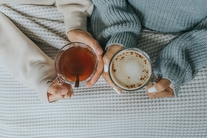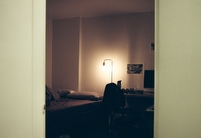
What is Cosymaxxing? Why this wellness trend matters in interior design
More than just a place to rest, our living spaces are now considered an extension of our self-care routine.



Since the pandemic hit in 2020, the popularity of working from home has drastically increased all over the UK. While some employers have opted to make their companies fully remote, many have implemented a flexible or hybrid approach, allowing employees to experience the best of both worlds.
In light of this, the government has also recently introduced new legislation, giving millions of workers the opportunity to request flexible working from day one of their employment, instead of after 26 weeks in the job.
But just how many UK employees are currently being offered flexible working arrangements, and with the cost of household bills soaring amidst the current cost-of-living crisis, how many are opting to head back to the office again in a bid to cut costs?
To find out more about the nation’s attitudes about home working, we asked 1,000 UK office workers whether they are currently being offered flexibility regarding their working location, asking them their preference when it comes to home or office-based working.
Additionally, we sought to discover just where in the home UK employees are opting to work from the most, when not heading into the office.

Our research found that currently, three out of five (60%) office workers have a choice when it comes to picking their regular work location.
When workers are allowed to choose where they work from, over half (57%) opt to work from home the majority of the time, while two in five (43%) choose to commute into the office regularly instead.
However, when companies decide their employees’ place of work, less than one in ten (7%) are allowed to work from home full time. In contrast, the majority (60%) are told to come to the office every day when the decision is left to their employer, whilst a third of employees (33%) are given a hybrid mix, with set home and office days that they have to follow.
Although there was found to be a preference for home working amongst employees, many respondents told us that they are now findings themselves having to head back into the office for a variety of reasons.
Despite over two-fifths of workers (43%) sharing that the prefer working from home, they are now having to head back to the office because their employer requested them to do so.
A further third (32%) who like working from home more are actually returning to their office in an bid to save money. This comes as research from price comparison site Uswitch shows that remote workers use 75% more gas over the winter months and 25% more electricity than those heading into the office five days a week.

Respondents also revealed the top benefits they have found to working from home, with the most common being the money saved on commuting (69%).
Other top reasons given for preferring home working included having a better work/life balance (67%), finding it calming (65%), and being able to get chores done alongside their work (59%).
| Top reasons we prefer working from home | Percentage of UK workers |
| I save money on commuting | 69% |
| It gives me a better work/life balance | 67% |
| I find it calming | 65% |
| I get chores done | 59% |
| I am more productive | 58% |
While over half of workers (58%) said they feel more productive at home than in the office, some respondents did admit that they prefer to work from home as it means they can get away with doing less work (30%)!
So, just where are we setting up our workspace for the day when working from home?
Well, according to our findings, whilst almost two thirds of UK employees who work from home in some capacity are doing so from a desk or standing equivalent (63%), one in five (19%) admit they don’t work from a desk at all.
Worryingly, those who choose not to use a desk are instead opting for their sofa (4%), kitchen sides or table (3%), landing or hallway (3%), or even their bed (3%) as their regular workspace.
| Top working from home locations | % Of UK workers who choose this location to work from |
| Home office or desk | 52% |
| Standing desk | 11% |
| Kitchen or dining table | 6% |
| Sofa | 4% |
| Kitchen sides or countertops | 3% |
| Landing or hallway | 3% |
| Bed | 3% |
Of those that work from a desk, two-thirds (66%) had to buy their own furniture and a third (33%) were supplied with a desk from their employer.
Interestingly, almost half of those that work from standing desks said their employer had supplied their desk.
While employers need to make sure staff have the appropriate equipment to work from home, this doesn’t necessarily cover office furniture – so for the majority of workers, it’s left up to them to set up a home office that supports their needs and wellbeing.

Letting yourself sink into the coach after a busy meeting can feel relaxing at first, however, health experts have warned that a bad posture stemming from the above can lead to a range of injuries.
Hammonds spoke with Carla-Maria Hole, Associate Osteopath at Bright Osteopathy, who stressed the importance of striving for “ergonomic desk setups where the person's knees / hips / elbows are all at 90 degrees from each other, their chair fits perfectly under the desk, their screen and keyboard are in line with their arms and eye line”.
Sitting on a bed or a sofa, for example, can leave you without proper lumbar support. This causes your lower back to flex the opposite way than what it is designed to do, placing strain on the joints and muscles, Carla-Maria says.
While working on a kitchen table or worktop is another popular solution for some of our survey respondents, this can also lead to a whole host of possible injuries.
“If you’re sat at the kitchen table on a chair that can’t fit underneath the table, you end up leaning forwards, putting strain on your lower back, your neck and through your arms and shoulders,” Carla-Maria explains.
Furthermore, she suggests using a cushion behind your lower back and bringing your laptop closer to you which can encourage you to sit back in the chair.
While often thought of as healthier alternatives, standing desks are also not entirely risk-free. If the screen is not at a good eye height, the muscles at the front of your neck are being shortened and the ones at the back are being stretched. If you’re in this position for extended periods, it can cause an imbalance in this structure, the Associate Osteopath says.

Whilst working from home understandably has its perks for some, so too can heading back into the office. So, what exactly do the nation’s workforce prefer about being in the office?
The biggest reason UK employees were found to prefer to go back to the office to work was the social aspect of meeting and chatting to co-workers (52%). Other reasons UK employees enjoy a day in the office over working from home include the change of scenery (52%) and being able to put a boundary between work and home life (51%).
| Top reasons we prefer working from the office | Percentage |
| I can socialise with co-workers | 52% |
| It gives me a change of scene | 52% |
| It allows to me to put boundaries in place between work and home | 51% |
| I save money on bills | 45% |
| I am more productive | 42% |
Saving money on bills (45%) was another popular reason for heading back into the office amongst UK employees, however, most workers still feel that they can save more money by not commuting to the office and working from home instead (69%). Additionally, more workers say that they feel more productive at home (58%) than in the office (42%).
It is worth mentioning that nearly half of respondents (45%) feel that they have no preference towards home or office working, enjoying the flexibility to do both.
Our study found that residents in the majority of cities would choose to work from home if they were given the option to do so. However, it seems that the ability to choose working location seems to vary from location to location.
The majority (68%) of office workers in Nottingham can choose their working location, making it the most flexible city in the study. In comparison, just a third (33%) of Liverpool office workers get to decide whether they work from home or the office.
The cities that have the most choice when it comes to their working location are:
On the other hand, the cities offering the least flexibility are:
Even as more employees head back to the office, it’s clear that full time commuting isn’t on the cards for everyone as the majority of workers prefer to work from home instead of going to the office. Worryingly though, our study has certainly shown us that some UK employees are not working from an adequate space when at home, which could lead to back and neck injuries down the line.
Whether you prefer working from home or in an office environment, it is important that your space is as comfortable as possible to allow you to focus on the task at hand, maximise your productivity and minimise the chance of injury!
Even if you don’t have the room for a dedicated home office, you’d be surprised what you can create from even the most awkward spaces. Your under-the-stairs nook, landing space or the corner of your living room could be transformed into a desk space to help you make the most of working from home.
Fitted home office furniture can be adapted to suit unusual shapes and fit many different interior styles. This can get around the issue of having to find your own furniture in the perfect dimensions.
Have a look at our home office selections to see if there are any ways you can improve your work from home setup.

More than just a place to rest, our living spaces are now considered an extension of our self-care routine.

Your teenage years are hugely transformational, and it's a time of rapid change.

Set a precedent for the new year by decluttering your home using tips from our experts.
Whether you have an exact vision in tow, or are just at the beginning stage of your home renovation, we have heaps of inspiration for you to get stuck into.
Find a wealth of design tips, trends and inspiration in the pages of our brochure, magazine and on our blog. Our experts are always ready to help you create dream home, pop in store or book your free design visit for experts to help on bringing your vision to life.